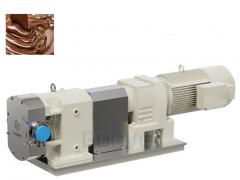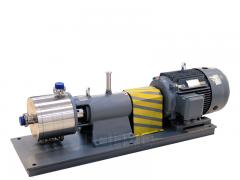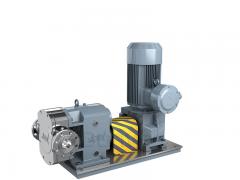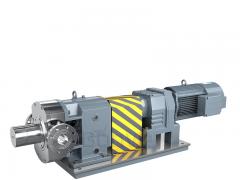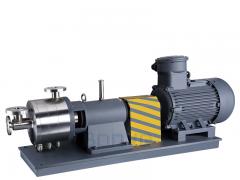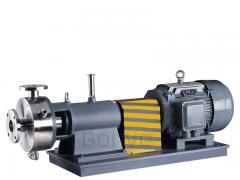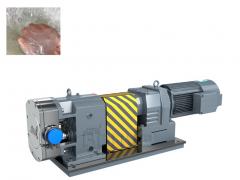How to deal with unreasonable process pump design and non-optimal operation?
Practical experience tells us that the use of centrifugal and positive displacement pumps in process often underestimates the challenges in planning design, assembly, operation and culture. Experienced operators have repeatedly stressed that premature failure of process pumps is often due to incorrect selection, incorrect installation, improper maintenance, and improper use.
In practice, process pump manufacturers usually get information on pipeline design, process technology and process media provided by the operator, but unfortunately the information provided is not always constant, but it's changing as process pump design progresses. If the operator does not communicate the changed data to the manufacturer, it will inevitably cause problems after production and use. After the
production process pump is installed, it will not work under ideal conditions, or it will be damaged after a short period of time. This is a completely avoidable situation.
Of course, change management is also a very important topic for other process equipment components, such as change management of compressors or fans. However, in terms of importance, the change management of the process pump is particularly important. For example, the designed centrifugal pump displacement is 100 m3/h, the pipe length is 100 m, and when the pipe length is extended by 10 m or the pipe diameter is changed, working point of centrifugal pump will change dramatically, making the centrifugal pump simply unable to complete the task it should accomplish. Again, these changes can have serious adverse effects on the performance of positive displacement pumps.
Ultimately, these adverse effects can seriously affect the life cycle of the process pump. If the process pump does not run at the optimal workstation, it will inevitably increase the cost and expense of maintenance.
In addition to improper operation, most process pump failures are related to changes in pumped media or changes in operating mode. Only the process pump function within the company can make reasonable feedback when the process pump work conditions change. Without this indispensable coordination mechanism, process pump technology, pipeline design and process control technology cannot be organically combined. Getting together and correctly understanding the relationship between them will eventually lead to the use of process pumps that are difficult to accomplish.
How to deal with unreasonable process pump design and non-optimal operation? The process pump expert gave the following recommendations.
1. Organization and management level
Retain the rich experience inside the company, set up the process pump management department, each process equipment operator should have a certain level of process pump technical expertise. Even if the technical service company outside the operator undertakes most of the work related to the process pump, the field operator of the process equipment operator should have certain expertise, such as proposing reasonable suggestions for improving daily operations.
In addition, companies need to always plan and design their process pumps and process equipment systems as a whole. If the partner in the process design stage of the process pump does not have a little knowledge of process pump technology, the design results will not be optimal.
2. Participate in the forum of professional and technical knowledge exchange
It is very necessary to exchange experiences at relevant meetings. It is different from daily work every day. It is very beneficial to contact some peers with similar experiences and problems and keep in touch and exchange experiences. The management of the process equipment operator company should be aware that the employees attending such meetings will return to your business with a low-cost solution. You must have a small amount of money in your hands to save a lot of money when planning, designing, installing, and commissioning process pumps.
3. Make full use of the training opportunities provided by the manufacturer
In principle, technical training provided by process pump manufacturers is a good time to learn new technologies and new knowledge, and companies should make full use of these training opportunities. Since the knowledge of process pump technology in many operators is not concentrated in one department, it is one of the reasons for not receiving good results. If a single operation engineer participates in such technical training, the training effect is weakened.
4. Maintenance is the value of maintenance
Practice has shown that in recent years, especially in large industrial enterprises, the concept of maintenance has undergone fundamental changes. Maintenance personnel are continually decreasing, and the loss of technical expertise leads to poor schedule maintenance of process pumps or the inability to implement maintenance plans. The result is usually not a reduction in expected costs, but an increase in maintenance costs and the loss of unplanned process pump lockout failure. Therefore, the manager of the enterprise should not regard maintenance as a cost library that consumes resources and expenses, but should be understood as a measure of preservation of asset value preservation.
5. Avoid assembly errors and suppress vibration
The operator may start making mistakes during the assembly process, such as twisting the pipe to the process pump, which will cause the process pump body to warp and the bearing clearance to be incorrect, which will quickly assemble the process pump. Workers and pipe fitters are overwhelmed.
Under unfavorable operating conditions, each system generates a strong resonance through the natural frequency and is destroyed in a short period of time, such as bearings. Process pumps operating in series are more intense due to the similar speed, and an effective solution is to choose a larger speed difference. Installing a vibration sensor is also a good remedy.
6. Using the monitoring system
It is more important for qualified employees to look, listen and smell at the process of the pump work than any other electronic monitoring. You don't have to pay attention to the latest technical development announcement. The tried and tested technology has been very useful for many years, using IDM sound control and variable speed drives to ensure that the operation is flawless. In addition, in the digital age, you must also learn how to correctly interpret the generated data. This requires a deep understanding of process pump technology, and it means that we are back to the topic of know-how. Monitoring technology is not a panacea. If the design or installation of the process pump is wrong, even the best monitoring technology can only play a limited role.
7. Using speed adjustment
When companies are aware of deficiencies in the organization and technology, and are unable to take effective remedies in the short term, there are other ways to reduce process pump problems, such as adjusting the speed of the process pump drive motor. This greatly increases the flexibility of the process pump operation and also calibrates the operating point of the process pump at any time. Of course, the cost of this flexibility is also relatively high (electrical control cabinets, frequency converters, shielding, etc. are often the same as a process pump). In addition, the energy efficiency of this formulation is not optimal.
8. Preventive maintenance is an opportunity
Pattern recognition with big data and intelligent data and artificial intelligence is an important tool in preventive maintenance. But it must be noted that there is not much distance between people and technology, especially in the analysis of data. In general, the benefits of preventive maintenance are overestimated, and most mechanical equipment failures stem from factors that preventive maintenance cannot solve, the most obvious of which is operator error.
9. Use the potential of standardization
Why is standardization so important? On the one hand, there are fewer and fewer people who know the various pump systems at the production site. If standardization is achieved, some operational problems can be solved. On the other hand, the number of inventory parts is less and less.
Another advantage of standardization is operation. A framework agreement can be signed with the manufacturer, and it is sufficient to call the type of process pump specified in the supply agreement when needed.
In addition to saving time, this approach offers an attractive purchasing advantage.




